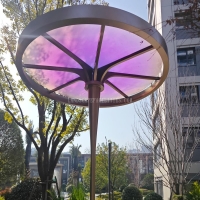Welcome to the website for landscape facilities products and knowledge.
How does concrete resist freeze-thaw cycles in landscape planter boxes?
Concrete landscape planter boxes face significant challenges from freeze-thaw cycles, especially in colder climates. The key to their durability lies in three critical factors: air entrainment, proper mix design, and surface protection.
1. Air Entrainment: Modern concrete mixes incorporate microscopic air bubbles (3-8% by volume) through chemical admixtures. These tiny voids act as pressure relief chambers when water freezes and expands, preventing internal cracking.
2. Low Water-Cement Ratio: A mix with 0.40-0.45 water-cement ratio creates a denser matrix that absorbs less moisture while maintaining workability with plasticizers.
3. Supplementary Cementitious Materials: Fly ash or slag (15-25% replacement) refines pore structure and reduces permeability by up to 50% compared to plain concrete.
4. Surface Treatments: Penetrating sealers (silane/siloxane based) form hydrophobic barriers that repel water while allowing vapor transmission, reducing saturation levels by 60-80%.
5. Proper Drainage Design: Planter boxes with 1/4" per foot slope and weep holes prevent water accumulation - the primary cause of freeze-thaw damage.
Field studies show properly designed concrete planters withstand 300+ freeze-thaw cycles without significant damage, outperforming untreated concrete by 8-10 times. The combination of material science and smart detailing creates planters that maintain structural integrity through seasonal temperature fluctuations while supporting healthy plant growth.
Related search:

Recommendation
Metal frame with gradient color acrylic combined with high-end shading landscape facilities